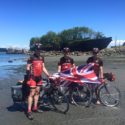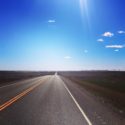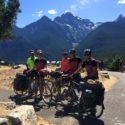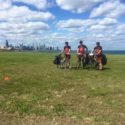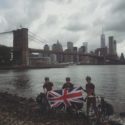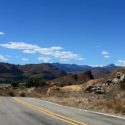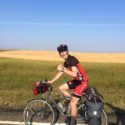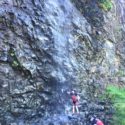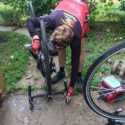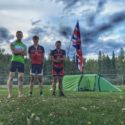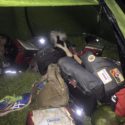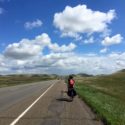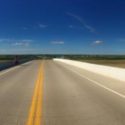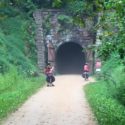Exercise Rolling Eagle saw a team of three officer cadets from Exeter University Officer Training Corps embark upon a trans-continental cycling challenge, crossing North America from Seattle, Washington, to New York City. The expedition aimed to improve the organisational, planning and leadership skills of those involved, in addition to presenting a physical and mental challenge and raising money for the Army Benevolent Fund, and Dartmoor Search and Rescue. This also presented the opportunity to gain an insight to the military institutions and heritage of the United States. The challenge was thus: Cycle an estimated 4000 miles self-supported across North America, carrying all equipment and provisions on our bikes.
Planning began in September 2014, including purchase of the bikes and equipment, and securing sponsorship for the venture from a bike shop and a clothing manufacturer. As a team we trained on multi-day rides across Cornwall, Devon, Somerset and South Wales, with an ample supply of hills in our home county of Devon to prepare us in some way for the climbs of the Rockies. As cycling novices, the training rides gave us the opportunity to refine our equipment needs to the bare essentials, and familiarise ourselves with life out of a pair of panniers, establishing a routine. We logged close to 700 miles in training.
On the 14th July, with the bikes securely boxed, we flew to Seattle, later travelling to Annacortes, our starting point on the West coast. We unboxed the bikes and assembled them in the ferry terminal car park, noting that the baggage handlers were not merciful, with a fair share of minor bumps and chips between the three bikes. We dipped our wheels in the Pacific, before embarking towards the Cascade Mountains in the distance; two snapped chains and three punctured inner tubes later we reached the first campsite, wondering what exactly we had gotten ourselves into! Thankfully, this constituted some of the worst maintenance problems we would face in a single day for the rest of the venture.
The first phase of the trip involved crossing the five main mountain passes of the Cascades. We would climb all morning until mid-afternoon, before a swift descent of an hour or so to the valley floor and the campsite for the evening, ready to start the next pass in the morning. This phase also coincided with a heatwave in the region, and as well as long mountain passes we contended with soaring temperatures in excess of 45 degrees Celsius at times. The scenery here was some of the most spectacular of the journey, with looming peaks above us, and dense pine forest lining the road. A 40mph descent off Washington Pass, around a stunning hairpin bend, the rock faces illuminated by the sunset behind was a highlight for us all. The most remote cycling was here also, with stretches of up to 70 miles between services; we relied on the sparse local population, rivers and even a snowmelt waterfall for drinking water in the searing heat.
A stretch of arid land separates the Cascades from the Rockies, populated by “Eureka towns” proudly displaying their gold rush heritage. Into the Rocky Mountains, we were taken in by a local ranger who shared a wealth of information on the local park, its wildlife, conservation and tourism. A vast forest fire closed the Going to the Sun road through the heart of the park, forcing us to make a detour South to a slightly smaller pass across the Continental Divide and out of the mountains. Our expectations of a long descent from the mountains were dashed as the road simply levelled out after the divide, and we struck out into the Great Plains.
The first phase of the journey was a test of physical endurance over long passes and through remote wilderness. This second phase through the Great Plains would prove to be a test of mental endurance. Arrow straight roads with naught but wheat and ourselves for company. Towns were 30 miles apart, roughly the distance a wagon train could cover in a day. The region is the “breadbasket of America”; One day the only scenery was a colossal grain lift, which we cycled towards for one and a half hours, passed, and took a further one and a half hours to cycle away from. In this region we had to adjust our sense of distance. On sighting a water tower, signalling a town, it was still six miles away; a length of three miles of road, denoted by the mile markers along the side, was a regular sight stretched in front of us. Some straights were in excess of 40 miles in length. We supported each other through the morale peaks and troughs, and used this as an opportunity to log some of our longest days, many over 100 miles.
During the Great Plains we typically camped in town parks on route. As we approached some of the more urbanised areas we were taken in by local cyclists who kindly offered us a place to stay indoors. From Fargo onwards, as we left the plains, the population became denser and we were taken in more regularly. Around one third of the accommodations we had were in locals’ homes. This gave us a unique insight into the lifestyles of locals across the United States and the chance to compare the similarities and differences of daily life in our two countries.
As we left the plains we left behind the stretches of endless wheat, and were instead greeted by expanses of corn fields and soy beans. From the straight roads of Eastern Montana and interstate highway of North Dakota, we now increasingly found cycle routes to follow, along crushed limestone paths without traffic. A relief after several close calls with lorries on the busier roads, including one incident where a lorry made contact with Jake’s pannier!
We left behind the detailed route and maps of the Adventure Cycling Association, which we had been following for the previous three weeks. From here on we relied on state mapping and GPS for navigation, combined with knowledge and instincts about finding amenities gained over the previous month. From Fargo, we struck South East to the Mississippi, following the river for a couple of days before crossing. This was the next major milestone in our journey, just over 2000 miles in. From the Mississippi onwards we found ourselves in each state for only a few days now, as opposed to the weeks spent in Montana. We followed a network of old railway lines turned cycle routes through Wisconsin and Illinois. Several days spent in Chicago gave us some time to recuperate.
The final 1100 miles took us through Michigan towards Detroit, where we witnessed a city gradually being overtaken by nature as services had stopped following bankruptcy. We had the freedom of a six lane highway into the heart of the city, which lay empty even at rush hour. From Detroit, we packed the bikes onto a car of a friendly local who had taken us in, and ferried them over the river into Canada. We followed the Lake Erie shoreline towards Niagara Falls, making up some longer days again in excess of 100 miles. Michigan and Canada were characterised by the exceptional generosity of the people we met there, some even organising us locations to stay with friends for the coming days. For over a week we did not have to cook ourselves a meal! At Niagara Falls we stopped for some sightseeing, including a flypast by the Canadian Snow Birds, before cycling over the Niagara and into New York State.
By this stage the long days had paid off and we had two weeks to make the final 500 miles. This meant we could take a leisurely pace down the 330 mile Erie Canal, stopping to enjoy attractions such as the New York State Fair on route. 330 miles of flat canal path was a welcome change for our tired legs! At the State Capital Albany we turned South for the final leg along the Hudson River. Long hills returned with a vengeance, combined with congested roads and a lack of cycle friendly shoulders. We stopped by West Point Military Academy to see their officer training establishment, as well as numerous university campuses all across America each having their own ROTC units. It was through speaking to locals who had attended these establishments that we gained an insight into the American counterpart to our OTC.
The Appalachians proved the final hurdle to overcome, as we ascended for a day into Harriman State Park, ready to drop down to Manhattan the following morning. After two weeks of being taken in by locals and fed, it was fitting that we spend our final night as we started, sat around a campfire in a state campground surrounded by woodland. A final 40mph descent the next day took us to our road into Manhattan, where we would be spurred on by the Saturday riders shouting encouragement, and even join a small group running a remembrance marathon, securing us police escort through Manhattan to the World Trade Centre! Finally, we crossed the Brooklyn Bridge to dip our wheels in the Atlantic, officially finishing our trans-continental challenge after 3743 miles and 59 days on the road, and raising £1500 for the ABF and Dartmoor Rescue Group in the process.
Exercise Rolling Eagle gave us the valuable experience of seeing a long term project through from conception to completion over the course of a year. All planning, resourcing and training was organised by the team and prepared us well for the physical and logistical challenges ahead during the expedition. We are all in the process of reflecting upon what has proven to be an unforgettable and invaluable experience.
A detailed daily account of the venture can be found at www.exrollingeagle.blogspot.co.uk

